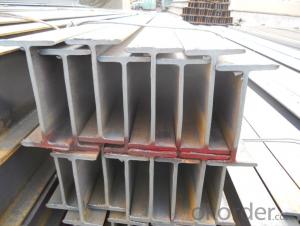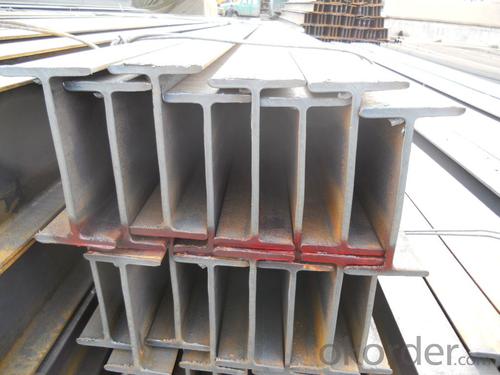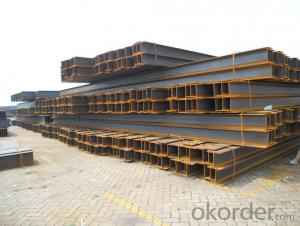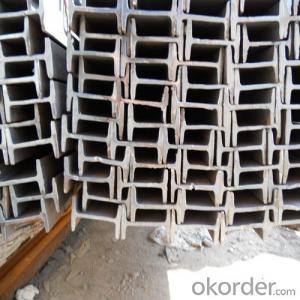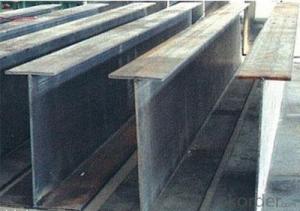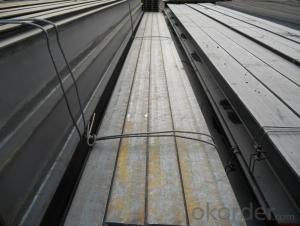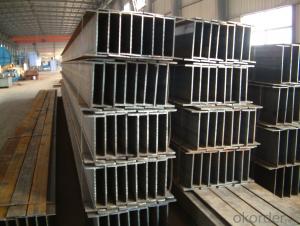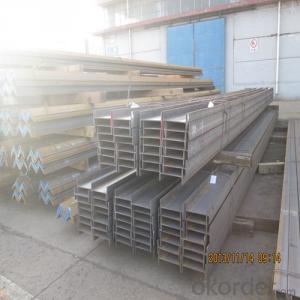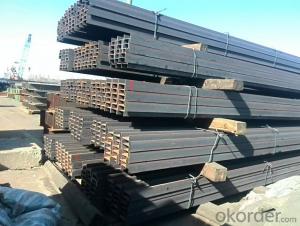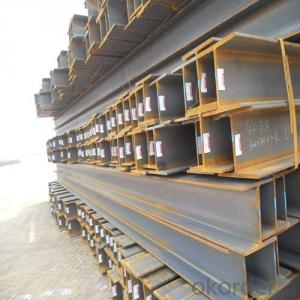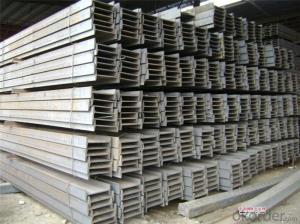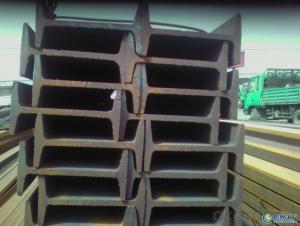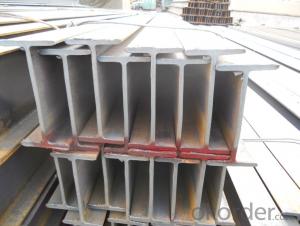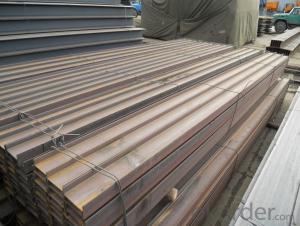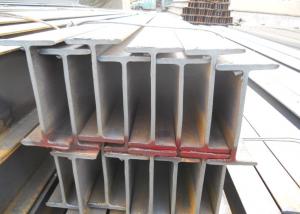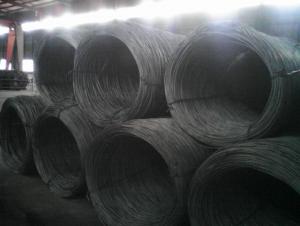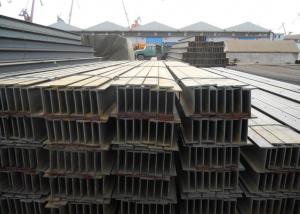Prime Low Carbon Hot Rolled H Beam at Length 12m
- Loading Port:
- China main port
- Payment Terms:
- TT OR LC
- Min Order Qty:
- 100 m.t.
- Supply Capability:
- 10000 m.t./month
OKorder Service Pledge
OKorder Financial Service
You Might Also Like
Product Description:
OKorder is offering Prime Low Carbon Hot Rolled H Beam at Length 12m at great prices with worldwide shipping. Our supplier is a world-class manufacturer of steel, with our products utilized the world over. OKorder annually supplies products to African, South American and Asian markets. We provide quotations within 24 hours of receiving an inquiry and guarantee competitive prices.
Product Applications:
Prime Low Carbon Hot Rolled H Beam at Length 12m are ideal for structural applications and are widely used in the construction of buildings and bridges, and the manufacturing, petrochemical, and transportation industries.
Product Advantages:
OKorder's Prime Low Carbon Hot Rolled H Beam at Length 12m are durable, strong, and wide variety of sizes.
Main Product Features:
· Premium quality
· Prompt delivery & seaworthy packing (30 days after receiving deposit)
· Can be recycled and reused
· Mill test certification
· Professional Service
· Competitive pricing
Product Specifications:
Manufacture: Hot rolled
Grade: Q195 – 235
Certificates: ISO, SGS, BV, CIQ
Length: 12m
Packaging: Export packing, nude packing, bundled
| H BEAM | ||||||
| size | h (MM) | b (MM) | t1 (MM) | t2 (MM) | Mass: Kg/m | LENGTH |
| 100x100 | 100 | 100 | 6.0 | 8 | 16.9 | 12M |
| 125x125 | 125 | 125 | 6.5 | 9 | 23.6 | 12M |
| 150x75 | 150 | 75 | 5.0 | 7 | 14.0 | 12M |
| 148x100 | 148 | 100 | 6.0 | 9 | 20.7 | 12M |
| 150x150 | 150 | 150 | 7.0 | 10 | 31.1 | 12M |
| 175x90 | 175 | 90 | 5.0 | 8 | 18.0 | 12M |
| 175x175 | 175 | 175 | 5.0 | 11 | 40.4 | 12M |
| 198x99 | 198 | 99 | 4.5 | 7 | 17.8 | 12M |
| 200x100 | 200 | 100 | 5.5 | 8 | 20.9 | 12M |
| 194x150 | 194 | 150 | 6.0 | 9 | 29.9 | 12M |
| 200x200 | 200 | 200 | 8.0 | 12 | 49.9 | 12M |
| 200x204 | 200 | 204 | 12.0 | 12 | 56.2 | 12M |
| 248x124 | 248 | 124 | 5.0 | 8 | 25.1 | 12M |
| 250x125 | 250 | 125 | 6.0 | 9 | 29.0 | 12M |
| 244x175 | 244 | 175 | 7.0 | 11 | 43.6 | 12M |
| 250x250 | 250 | 250 | 9.0 | 14 | 71.8 | 12M |
| 250x255 | 250 | 255 | 14.0 | 14 | 81.6 | 12M |
| 298x149 | 298 | 149 | 5.5 | 8 | 32.0 | 12M |
| 300x150 | 300 | 150 | 6.5 | 9 | 36.7 | 12M |
| 294x200 | 294 | 200 | 8.0 | 12 | 55.8 | 12M |
| 294x302 | 294 | 302 | 12.0 | 12 | 83.4 | 12M |
| 300x300 | 300 | 300 | 10.0 | 15 | 93.0 | 12M |
| 300x305 | 300 | 305 | 15.0 | 15 | 105.0 | 12M |
| 346x174 | 346 | 174 | 6.0 | 9 | 41.2 | 12M |
| 350x175 | 350 | 175 | 7.0 | 11 | 49.4 | 12M |
| 340x250 | 340 | 250 | 9.0 | 14 | 78.1 | 12M |
| 344x348 | 344 | 348 | 10.0 | 16 | 113.0 | 12M |
| 350x350 | 350 | 350 | 12.0 | 19 | 135.0 | 12M |
| 396x199 | 396 | 199 | 7.0 | 11 | 56.1 | 12M |
| 400x200 | 400 | 200 | 8.0 | 13 | 65.4 | 12M |
| 400x300 | 400 | 300 | 10.0 | 16 | 105 | 12M |
| 388x402 | 388 | 402 | 15.0 | 15 | 140 | 12M |
| 394x398 | 394 | 398 | 11.0 | 18 | 147 | 12M |
| 400x400 | 400 | 400 | 13.0 | 21 | 172 | 12M |
| 400x408 | 400 | 408 | 21.0 | 21 | 197 | 12M |
| 414x405 | 414 | 405 | 18 | 28 | 232 | 12M |
| 428x407 | 428 | 407 | 20 | 35 | 283 | 12M |
| 458x417 | 458 | 417 | 30 | 50 | 415 | 12M |
| 498x432 | 498 | 432 | 45 | 70 | 605 | 12M |
| 446x199 | 446 | 199 | 8 | 12 | 65.1 | 12M |
| 450x200 | 450 | 200 | 9 | 14 | 74.9 | 12M |
| 440x300 | 440 | 300 | 11 | 18 | 121 | 12M |
| 496x199 | 496 | 199 | 9 | 14 | 77.9 | 12M |
| 500x200 | 500 | 200 | 10 | 16 | 88.2 | 12M |
| 506x201 | 506 | 201 | 11 | 19 | 102 | 12M |
| 482x300 | 482 | 300 | 11 | 15 | 111 | 12M |
| 488x300 | 488 | 300 | 11 | 18 | 125 | 12M |
| 596x199 | 596 | 199 | 10 | 15 | 92.5 | 12M |
| 600x200 | 600 | 200 | 11 | 17 | 103 | 12M |
| 606x201 | 606 | 201 | 12 | 20 | 118 | 12M |
| 582x300 | 582 | 300 | 12 | 17 | 133 | 12M |
| 588x300 | 588 | 300 | 12 | 20 | 147 | 12M |
| 594x302 | 594 | 302 | 14 | 23 | 170 | 12M |
| 692x300 | 692 | 300 | 13 | 20 | 163 | 12M |
| 700x300 | 700 | 300 | 13 | 24 | 182 | 12M |
| 792x300 | 792 | 300 | 14 | 22 | 188 | 12M |
| 800x300 | 800 | 300 | 14 | 26 | 207 | 12M |
| 890x299 | 890 | 299 | 15 | 23 | 210 | 12M |
| 900x300 | 900 | 300 | 16 | 28 | 240 | 12M |
| 912x302 | 912 | 302 | 18 | 34 | 283 | 12M |
FAQ:
Q1: Why buy Materials & Equipment from OKorder.com?
A1: All products offered byOKorder.com are carefully selected from China's most reliable manufacturing enterprises. Through its ISO certifications, OKorder.com adheres to the highest standards and a commitment to supply chain safety and customer satisfaction.
Q2: How soon can we receive the product after purchase?
A2: Within three days of placing an order, we will arrange production. The normal sizes with the normal grade can be produced within one month. The specific shipping date is dependent upon international and government factors, the delivery to international main port about 45-60days.
Q3: How many tons of steel products could be loaded in containers?
A3: Usually the steel products are delivered by bulk vessel because of the large quantity and the freight. However, there are no bulk vessel enter some seaports so that we have to deliver the cargo by containers. The 6m steel product can be loaded in 20FT container, but the quantity is changed according to the size, usually from 18tons to 25tons.
Images:
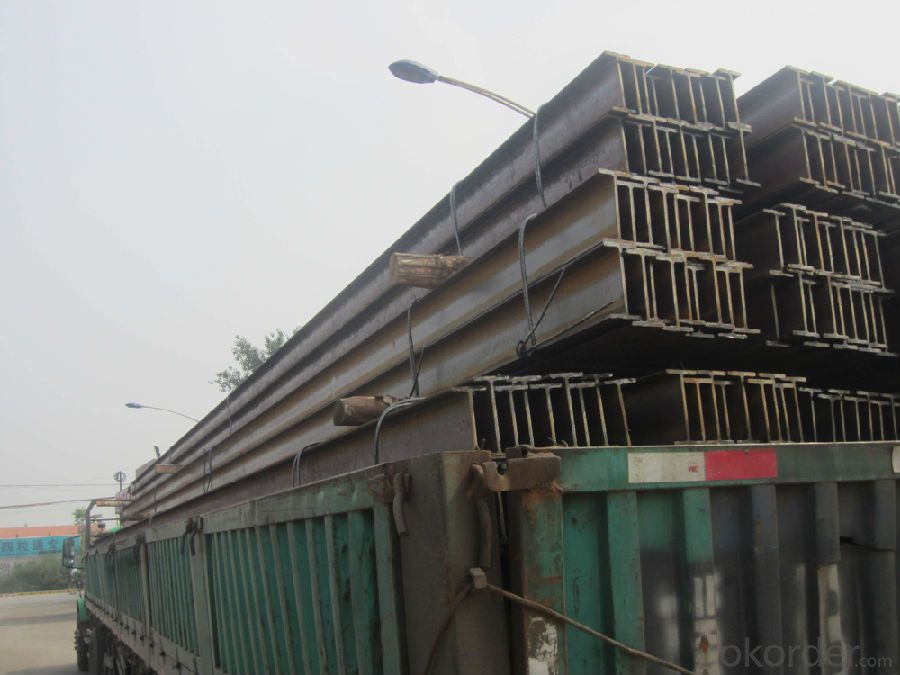
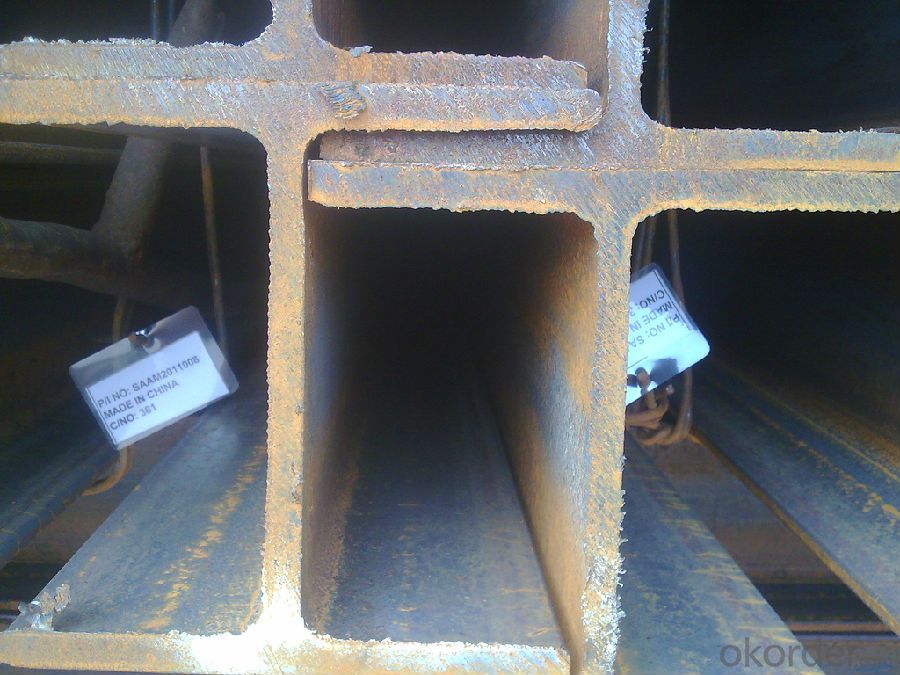
- Q: How do Steel H-Beams compare in terms of lifespan and durability?
- The exceptional lifespan and durability of steel H-Beams are well-known. These structural members are specifically designed to withstand heavy loads and provide long-lasting support for various construction projects. Unlike wood or concrete, the lifespan of steel H-Beams can be significantly longer. The durability of steel H-Beams can be attributed to several key factors. Firstly, steel itself is inherently strong, with superior tensile strength and resistance to bending and twisting forces. This enables the H-Beams to endure extreme weather conditions, seismic activity, and other external factors that could potentially damage structures over time. Moreover, steel H-Beams are not susceptible to rot, decay, or insect infestations like wooden beams. They also do not degrade or weaken under moisture, a common issue with concrete structures. This makes steel H-Beams highly durable and reliable, ensuring their long-term performance and structural integrity. Additionally, steel H-Beams are resistant to fire, further enhancing their lifespan and durability. Steel has a high melting point and does not contribute fuel to a fire, making it a safer choice for structural elements. This characteristic is particularly important in high-rise buildings or structures where fire protection is crucial. Furthermore, steel H-Beams can be easily inspected for signs of wear or damage. Regular maintenance and inspections can help identify and address any issues promptly, ensuring the continued durability and longevity of these structural members. In conclusion, steel H-Beams possess remarkable lifespan and durability due to their high strength, resistance to environmental factors, and fire resistance. These qualities make them an excellent choice for a wide range of construction projects where longevity and structural integrity are of utmost importance.
- Q: What are the different welding techniques used for steel H-beams?
- The different welding techniques commonly used for steel H-beams include shielded metal arc welding (SMAW), gas metal arc welding (GMAW), flux-cored arc welding (FCAW), and submerged arc welding (SAW). Each technique has its own advantages and limitations, and the choice of technique depends on factors such as the type of steel, joint design, and project requirements.
- Q: Are steel H-beams suitable for use in the construction of energy generation facilities?
- Steel H-beams are an excellent choice for constructing energy generation facilities due to their numerous advantages. Firstly, their strength and durability are well-known. Made from high-quality steel, they provide exceptional structural integrity, which is crucial for supporting heavy machinery and equipment commonly found in such facilities. Additionally, steel H-beams have impressive load-bearing capabilities. Designed to distribute weight evenly, they are ideal for supporting heavy equipment and structures in energy generation facilities, which often require large and heavy machinery like turbines and generators. Moreover, steel H-beams offer versatility and can be easily customized to meet specific project requirements. Available in various sizes and lengths, architects and engineers can design structures tailored to the unique needs of energy generation facilities. This adaptability makes steel H-beams suitable for a wide range of applications in energy facility construction. Furthermore, steel H-beams are fire-resistant, ensuring the safety of energy generation facilities. In the event of a fire, they do not contribute to the spread of flames, providing valuable time for evacuation and firefighting efforts. Lastly, steel H-beams have a long lifespan and require minimal maintenance, making them particularly advantageous for energy generation facilities. These facilities operate continuously and require reliable structural support. The durability and low-maintenance nature of steel H-beams contribute to the overall cost-effectiveness of constructing energy generation facilities. In conclusion, steel H-beams are an excellent choice for constructing energy generation facilities. Their strength, load-bearing capabilities, versatility, fire resistance, and low-maintenance qualities make them ideal for supporting heavy machinery and structures in these facilities.
- Q: Can steel H-beams be used in residential staircase or railing systems?
- Indeed, residential staircase or railing systems can make use of steel H-beams. Due to their robustness and endurance, steel H-beams are widely employed in construction. They offer exceptional structural reinforcement and are capable of bearing substantial weight. In the context of staircase or railing systems, steel H-beams guarantee stability and ensure safety. They can be tailor-made and manufactured to suit the precise demands and visual preferences of a residential area. Furthermore, steel H-beams can be adorned with diverse materials, such as wood or glass, to fashion an aesthetically pleasing staircase or railing system that harmonizes with the overall design of the dwelling.
- Q: Can steel H-beams be used in multi-story buildings?
- Yes, steel H-beams can definitely be used in multi-story buildings. These beams are widely used in construction due to their high strength and structural integrity. They provide excellent support and stability, making them suitable for withstanding the loads and stresses associated with multi-story structures.
- Q: How do you calculate the shear center of steel H-beams?
- To calculate the shear center of steel H-beams, you need to consider the beam's cross-sectional properties and geometry. This can be done using mathematical formulas or computer software designed for structural analysis. The shear center represents the point where the application of shear forces produces no twisting or bending of the beam, and its location can significantly affect the beam's structural behavior and stability.
- Q: Can steel H-beams be used in bridge construction?
- Indeed, steel H-beams have the potential to be utilized in the construction of bridges. Their strength, durability, and versatility make them a popular choice for bridge construction. The unique H-shape of these beams enables them to efficiently bear heavy loads and withstand diverse environmental conditions. Moreover, the fabrication process for steel H-beams is simple and efficient, leading to cost-effective bridge construction. The success of numerous projects worldwide has solidified the status of steel H-beams as a favored option for engineers and contractors in bridge construction.
- Q: What are the different types of steel H-beam connections for seismic-resistant buildings?
- There are several types of steel H-beam connections commonly used in seismic-resistant buildings. These include moment-resisting connections, shear connections, and combined moment-shear connections. Moment-resisting connections are designed to resist bending and rotational forces and are commonly used in beam-to-column connections. Shear connections, on the other hand, are used to transfer shear forces between beams and columns. Combined moment-shear connections combine both moment-resisting and shear connections to provide enhanced structural integrity and resistance against seismic events. The selection of the appropriate type of connection depends on factors such as the building design, seismic zone, and load requirements.
- Q: How do steel H-beams contribute to energy efficiency in buildings?
- Energy efficiency in buildings can be enhanced in various ways through the use of steel H-beams. Firstly, these beams are renowned for their strength and durability, enabling the construction of larger open spaces and window openings. This facilitates the entry of natural light into the building, reducing the reliance on artificial lighting during daylight hours. Not only does natural light reduce energy consumption, but it also positively impacts the well-being and productivity of occupants. Secondly, steel H-beams possess excellent thermal properties, including a high thermal mass that efficiently absorbs and stores heat energy. This characteristic regulates indoor temperature by slowing down the transfer of heat through the building envelope. Consequently, less energy is required for heating and cooling, resulting in decreased energy consumption and lower utility bills. Furthermore, steel H-beams play a crucial role in the insulation of buildings. They provide a stable framework for the installation of insulation materials such as mineral wool or foam. Proper insulation prevents thermal bridging, which involves the transfer of heat between the interior and exterior of a building through solid materials. By minimizing thermal bridging, steel H-beams significantly enhance the building's overall thermal performance, reducing the need for excessive heating or cooling. Additionally, steel H-beams are frequently utilized in the construction of green roofs and solar panel systems. Green roofs offer insulation, reduce stormwater runoff, and improve air quality. Solar panels harness renewable energy from the sun and convert it into electricity. Steel H-beams provide the necessary support and structural integrity for these sustainable features, further contributing to the building's energy efficiency. In conclusion, steel H-beams are essential components in the construction of energy-efficient buildings. Their ability to allow more natural light, provide excellent thermal properties, enable proper insulation, and support sustainable features makes them indispensable in enhancing energy efficiency. With their strength, durability, and versatility, steel H-beams play a vital role in constructing energy-efficient buildings.
- Q: What are the different types of steel H-beams available in the market?
- In the market, one can find a variety of steel H-beams with different designs and purposes. Each type is specifically tailored to meet specific structural requirements and applications. The common types are as follows: 1. W-beams (Wide flange beams): These are widely used H-beams with a wide flange section and parallel flanges. They possess excellent load-bearing capabilities and are suitable for various construction projects, including bridges, buildings, and heavy load support. 2. S-beams (I-beams or American Standard Beams): These H-beams have narrower flanges compared to W-beams. They are commonly used in structural steel construction and for columns and beams in residential and commercial buildings. 3. H-piles: These H-beams have a wider flange section and are primarily used as foundation piles in deep foundation systems. They are driven into the ground to provide support and stability for structures like bridges, piers, and buildings. 4. Junior beams: These H-beams are smaller in size and are often used in light-duty applications or where space is limited. They find common use in residential construction and the manufacturing of machinery and equipment. 5. Specialized H-beams: The market also offers specialized H-beams, such as stainless steel H-beams, which are corrosion-resistant and suitable for environments with high moisture or chemical exposure. Additionally, there are high-strength H-beams designed for industries like aerospace and automotive, where strength and durability are crucial. Overall, the presence of various types of steel H-beams ensures that there is an appropriate option available for every construction or structural project. Factors like load requirements, space limitations, and environmental conditions should be considered, and it is advisable to consult with structural engineers or industry professionals to determine the most suitable type of H-beam for a specific application.
Send your message to us
Prime Low Carbon Hot Rolled H Beam at Length 12m
- Loading Port:
- China main port
- Payment Terms:
- TT OR LC
- Min Order Qty:
- 100 m.t.
- Supply Capability:
- 10000 m.t./month
OKorder Service Pledge
OKorder Financial Service
Similar products
Hot products
Hot Searches
Related keywords
